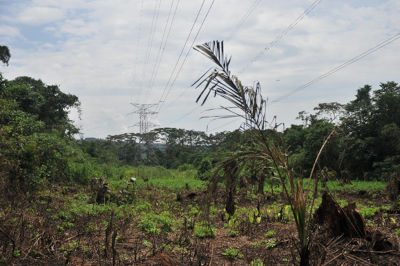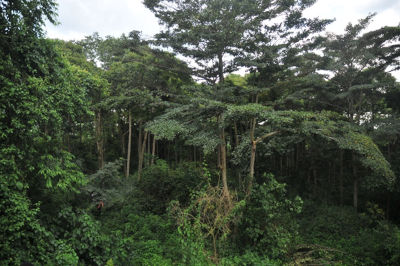

On the left is the high voltage electricity transmission line project implemented in Gangu Forest development site, and to the right is the Gangu Forest restoration site.
Uganda is among the top 10 biodiverse countries worldwide, with over 18,783 plant species. With the drive for Uganda’s improvement of income status, development initiatives must go on but with a commitment to protect the environment to prevent the loss of our natural heritage.
This requirement underpins Section 115 in the National Environment Act 2019, the International Finance Corporation Performance Standard 6 on Biodiversity Conservation, and Sustainable Management of Living Natural Resources. These clauses emphasize the importance of implementing the mitigation hierarchy that prioritizes avoiding adverse effects before minimizing those that cannot be avoided, restoring affected areas, and finally offsetting unavoidable residual impacts to reduce the detrimental impacts of development on biodiversity. These standards, laws, and policies must now be incorporated into Environment and Social Impact Assessments (ESIA) to address the challenges of potential impacts from developments on ongoing efforts to protect wildlife and ensure ecosystem services, which play a critical role in averting natural disasters and preserving humanity.
On October 10 -12, 2022, the Wildlife Conservation Society (WCS), in collaboration with National Environment Management Authority (NEMA), held a three-day mitigation hierarchy training for 31 ESIA practitioners/members of the Uganda Association for Impact Assessment (UAIA) with financial support from the Norwegian Agency for Development Cooperation (NORAD). This training aimed to equip the ESIA practitioners with the knowledge to design and guide implementation of the mitigation hierarchy, including biodiversity offsets, as a planning and management tool for biodiversity conservation. According to Caroline Agutti, the Chairperson of UAIA, “this training shall assist association members in improving the quality of reporting in the country as they help lead agencies and people in the private sector to develop and implement ESIA plans”.
NEMA has also developed the National Guidelines for Biodiversity and Social Offsets with support from the first phase of the WCS-implemented Conservation, Mitigation and Biodiversity Offsets (COMBO) project implemented in 2016—2019. The guidelines will guide project developers, regulatory agencies, and other stakeholders on biodiversity offsets to mitigate residual impacts and achieve measurable conservation outcomes. As such, Dr. Simon Nampindo, the WCS Country Director, emphasized the need for the ESIA practitioners to be knowledgeable about the mitigation hierarchy in an era where the land is not increasing, hence the impact of development on Key Biodiversity Areas (KBAs) and sensitive ecosystems, which would most likely have no suitable alternative place for offset implementation. He further emphasized the importance of conducting baseline biodiversity studies before any development process to prevent species loss through the inappropriate selection of offset sites.
Participants finally visited Gangu Forest, managed by the National Forestry Authority, where the Uganda Electricity Transmission Company Limited (UETCL) has routed the high-voltage transmission line and is undertaking forest restoration to compensate for the cleared areas to pave way for the transmission line. The visit helped the participants to understand the scope and extent of the development projects’ impacts on biodiversity and livelihoods. They also appreciated the challenges encountered in achieving mitigation targets attributable to the adverse effects of development projects and the complexity of biodiversity in the area. Finally, the participants appreciated why offsets are a last option type of mitigation after considering avoidance, minimization, and restoration of the consequences of development initiatives on biodiversity and the associated societal benefits since they are complex and very costly to implement.